Strategic and Change Management Report: Woolworths, Tesla, and GM
VerifiedAdded on 2023/04/24
|11
|2983
|495
Report
AI Summary
This report delves into strategic and change management practices, primarily using Woolworths, Tesla, and General Motors as case studies. It analyzes Woolworths' acquisition of David Jones, its private label strategies, and the leadership of Ian Moir. The report discusses the competitive landscape and the importance of understanding customer behavior. It then examines change management through Lewin's model (unfreeze, change, refreeze), highlighting the challenges of resistance and the role of leadership. Formal strategic planning systems are evaluated, particularly in dynamic, high-tech industries. Finally, the report explores Tesla's differentiation focus as a competitive strategy, including its Master Plan and the integration of renewable energy. The analysis covers strategic objectives, market expansion, and the application of intensive growth strategies. The report provides insights into how these companies navigate strategic challenges and leverage change for competitive advantage.
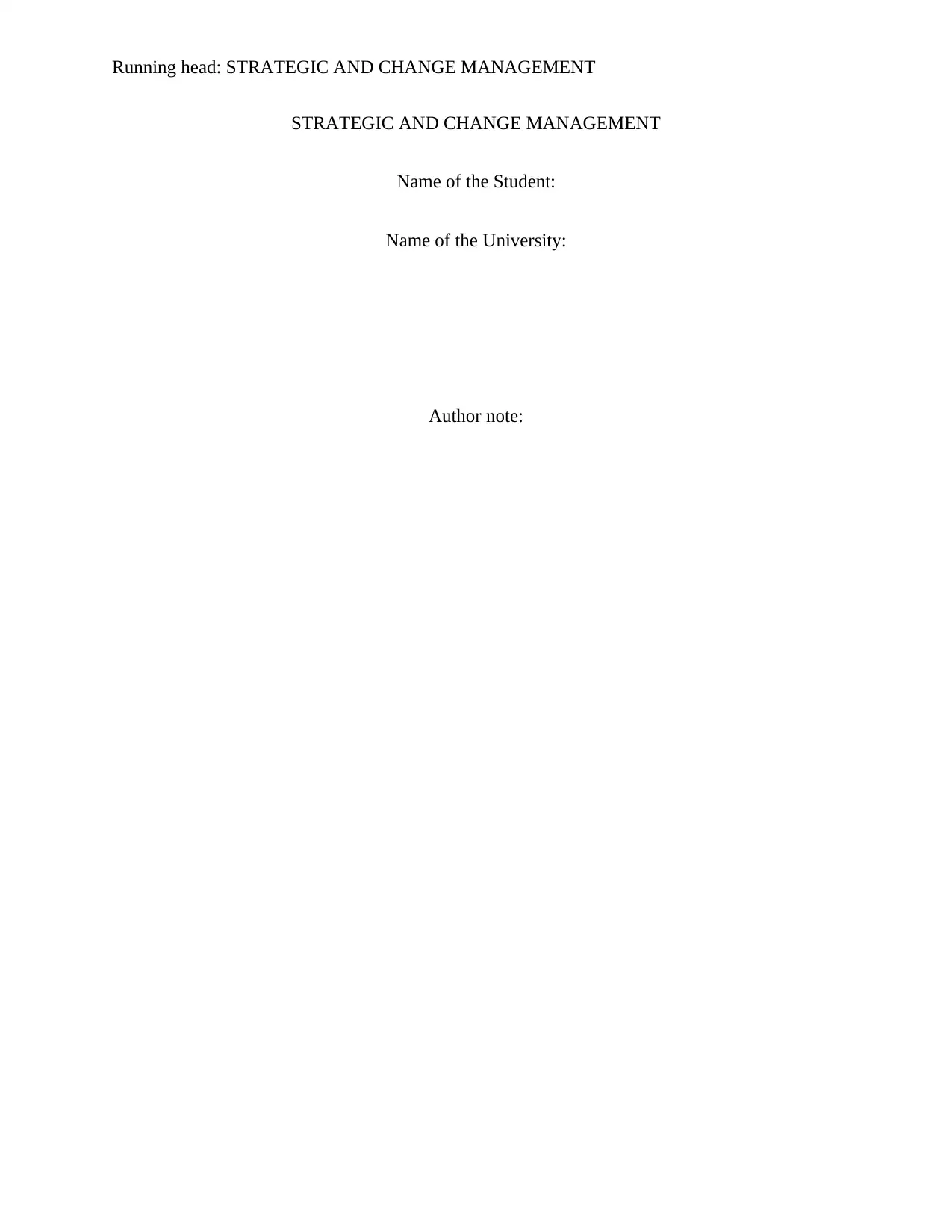
Running head: STRATEGIC AND CHANGE MANAGEMENT
STRATEGIC AND CHANGE MANAGEMENT
Name of the Student:
Name of the University:
Author note:
STRATEGIC AND CHANGE MANAGEMENT
Name of the Student:
Name of the University:
Author note:
Paraphrase This Document
Need a fresh take? Get an instant paraphrase of this document with our AI Paraphraser
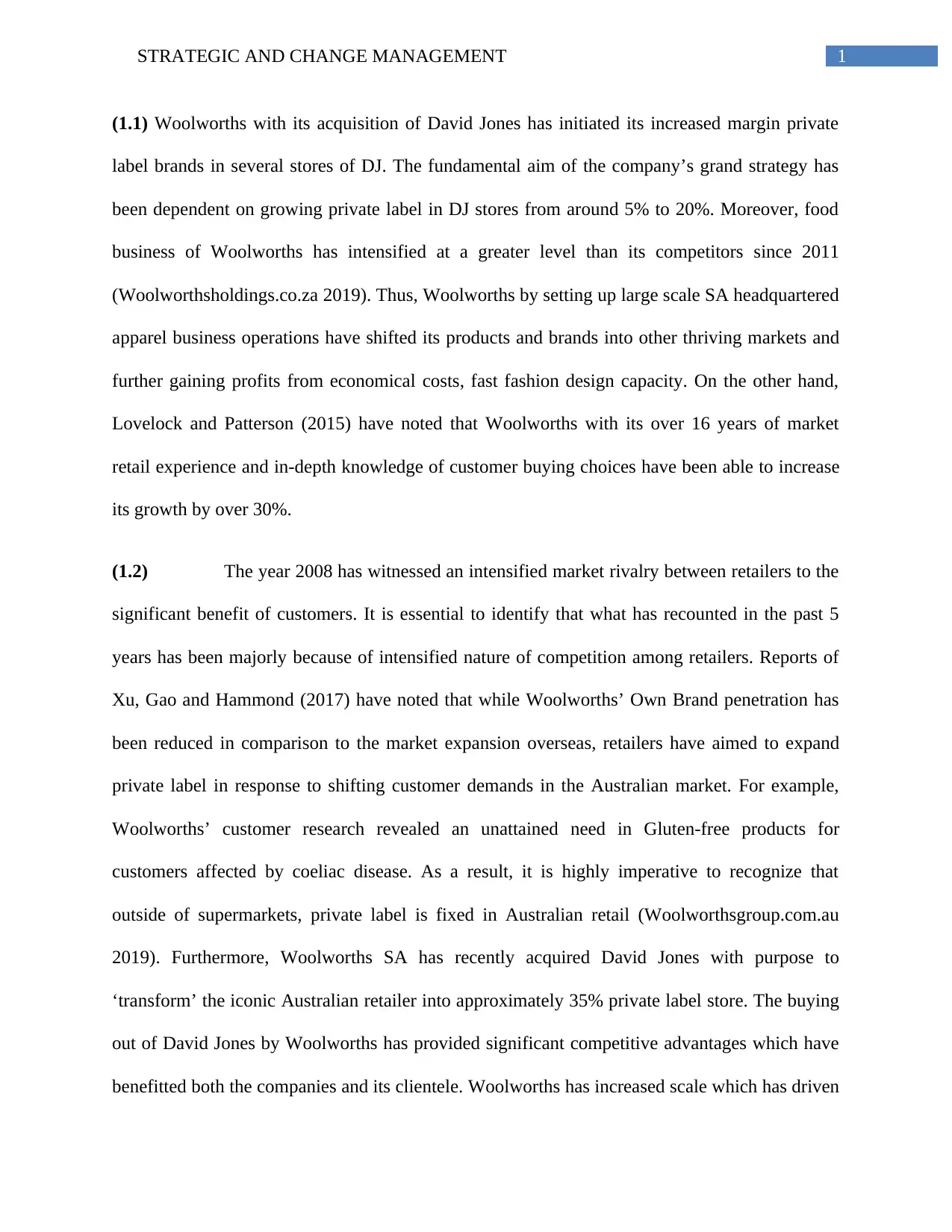
1STRATEGIC AND CHANGE MANAGEMENT
(1.1) Woolworths with its acquisition of David Jones has initiated its increased margin private
label brands in several stores of DJ. The fundamental aim of the company’s grand strategy has
been dependent on growing private label in DJ stores from around 5% to 20%. Moreover, food
business of Woolworths has intensified at a greater level than its competitors since 2011
(Woolworthsholdings.co.za 2019). Thus, Woolworths by setting up large scale SA headquartered
apparel business operations have shifted its products and brands into other thriving markets and
further gaining profits from economical costs, fast fashion design capacity. On the other hand,
Lovelock and Patterson (2015) have noted that Woolworths with its over 16 years of market
retail experience and in-depth knowledge of customer buying choices have been able to increase
its growth by over 30%.
(1.2) The year 2008 has witnessed an intensified market rivalry between retailers to the
significant benefit of customers. It is essential to identify that what has recounted in the past 5
years has been majorly because of intensified nature of competition among retailers. Reports of
Xu, Gao and Hammond (2017) have noted that while Woolworths’ Own Brand penetration has
been reduced in comparison to the market expansion overseas, retailers have aimed to expand
private label in response to shifting customer demands in the Australian market. For example,
Woolworths’ customer research revealed an unattained need in Gluten-free products for
customers affected by coeliac disease. As a result, it is highly imperative to recognize that
outside of supermarkets, private label is fixed in Australian retail (Woolworthsgroup.com.au
2019). Furthermore, Woolworths SA has recently acquired David Jones with purpose to
‘transform’ the iconic Australian retailer into approximately 35% private label store. The buying
out of David Jones by Woolworths has provided significant competitive advantages which have
benefitted both the companies and its clientele. Woolworths has increased scale which has driven
(1.1) Woolworths with its acquisition of David Jones has initiated its increased margin private
label brands in several stores of DJ. The fundamental aim of the company’s grand strategy has
been dependent on growing private label in DJ stores from around 5% to 20%. Moreover, food
business of Woolworths has intensified at a greater level than its competitors since 2011
(Woolworthsholdings.co.za 2019). Thus, Woolworths by setting up large scale SA headquartered
apparel business operations have shifted its products and brands into other thriving markets and
further gaining profits from economical costs, fast fashion design capacity. On the other hand,
Lovelock and Patterson (2015) have noted that Woolworths with its over 16 years of market
retail experience and in-depth knowledge of customer buying choices have been able to increase
its growth by over 30%.
(1.2) The year 2008 has witnessed an intensified market rivalry between retailers to the
significant benefit of customers. It is essential to identify that what has recounted in the past 5
years has been majorly because of intensified nature of competition among retailers. Reports of
Xu, Gao and Hammond (2017) have noted that while Woolworths’ Own Brand penetration has
been reduced in comparison to the market expansion overseas, retailers have aimed to expand
private label in response to shifting customer demands in the Australian market. For example,
Woolworths’ customer research revealed an unattained need in Gluten-free products for
customers affected by coeliac disease. As a result, it is highly imperative to recognize that
outside of supermarkets, private label is fixed in Australian retail (Woolworthsgroup.com.au
2019). Furthermore, Woolworths SA has recently acquired David Jones with purpose to
‘transform’ the iconic Australian retailer into approximately 35% private label store. The buying
out of David Jones by Woolworths has provided significant competitive advantages which have
benefitted both the companies and its clientele. Woolworths has increased scale which has driven
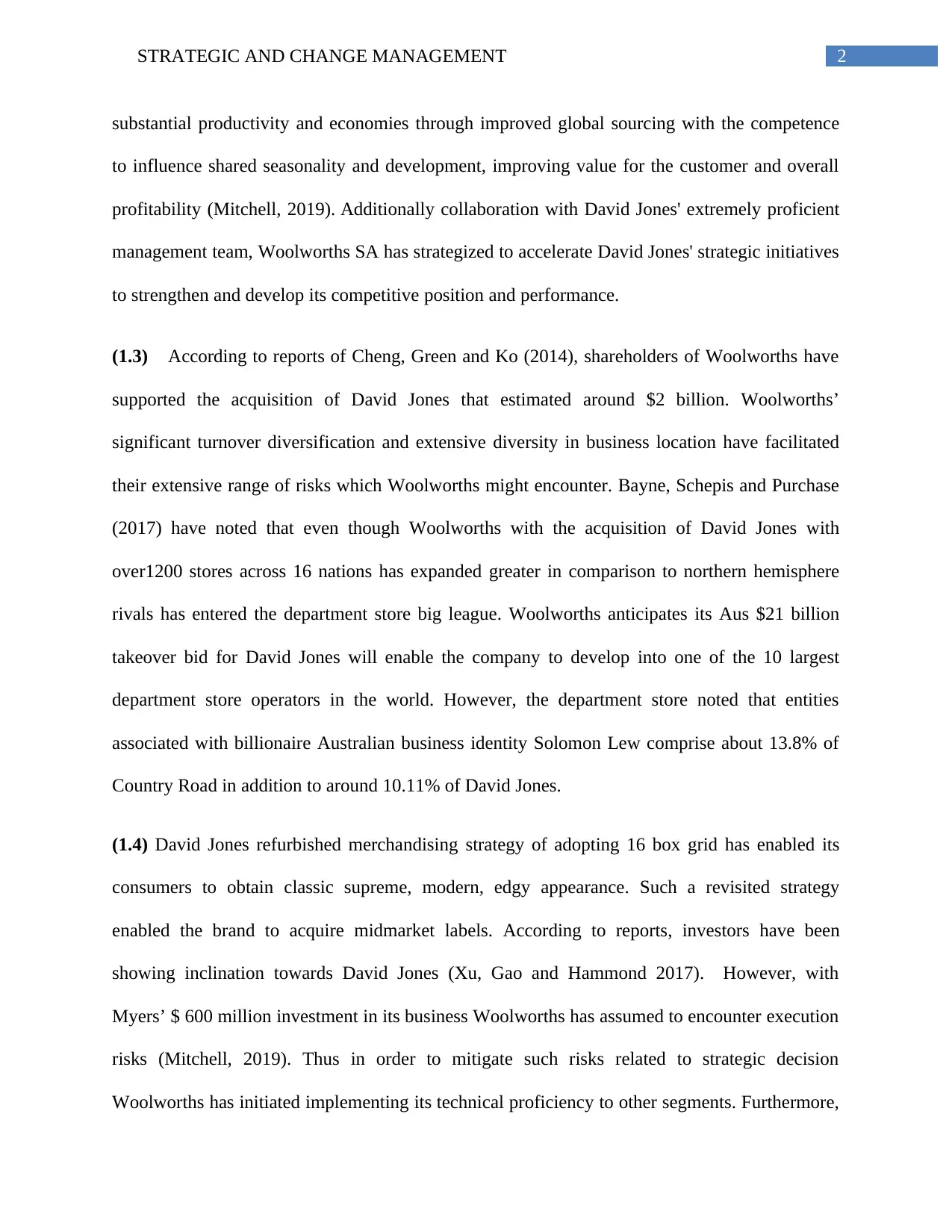
2STRATEGIC AND CHANGE MANAGEMENT
substantial productivity and economies through improved global sourcing with the competence
to influence shared seasonality and development, improving value for the customer and overall
profitability (Mitchell, 2019). Additionally collaboration with David Jones' extremely proficient
management team, Woolworths SA has strategized to accelerate David Jones' strategic initiatives
to strengthen and develop its competitive position and performance.
(1.3) According to reports of Cheng, Green and Ko (2014), shareholders of Woolworths have
supported the acquisition of David Jones that estimated around $2 billion. Woolworths’
significant turnover diversification and extensive diversity in business location have facilitated
their extensive range of risks which Woolworths might encounter. Bayne, Schepis and Purchase
(2017) have noted that even though Woolworths with the acquisition of David Jones with
over1200 stores across 16 nations has expanded greater in comparison to northern hemisphere
rivals has entered the department store big league. Woolworths anticipates its Aus $21 billion
takeover bid for David Jones will enable the company to develop into one of the 10 largest
department store operators in the world. However, the department store noted that entities
associated with billionaire Australian business identity Solomon Lew comprise about 13.8% of
Country Road in addition to around 10.11% of David Jones.
(1.4) David Jones refurbished merchandising strategy of adopting 16 box grid has enabled its
consumers to obtain classic supreme, modern, edgy appearance. Such a revisited strategy
enabled the brand to acquire midmarket labels. According to reports, investors have been
showing inclination towards David Jones (Xu, Gao and Hammond 2017). However, with
Myers’ $ 600 million investment in its business Woolworths has assumed to encounter execution
risks (Mitchell, 2019). Thus in order to mitigate such risks related to strategic decision
Woolworths has initiated implementing its technical proficiency to other segments. Furthermore,
substantial productivity and economies through improved global sourcing with the competence
to influence shared seasonality and development, improving value for the customer and overall
profitability (Mitchell, 2019). Additionally collaboration with David Jones' extremely proficient
management team, Woolworths SA has strategized to accelerate David Jones' strategic initiatives
to strengthen and develop its competitive position and performance.
(1.3) According to reports of Cheng, Green and Ko (2014), shareholders of Woolworths have
supported the acquisition of David Jones that estimated around $2 billion. Woolworths’
significant turnover diversification and extensive diversity in business location have facilitated
their extensive range of risks which Woolworths might encounter. Bayne, Schepis and Purchase
(2017) have noted that even though Woolworths with the acquisition of David Jones with
over1200 stores across 16 nations has expanded greater in comparison to northern hemisphere
rivals has entered the department store big league. Woolworths anticipates its Aus $21 billion
takeover bid for David Jones will enable the company to develop into one of the 10 largest
department store operators in the world. However, the department store noted that entities
associated with billionaire Australian business identity Solomon Lew comprise about 13.8% of
Country Road in addition to around 10.11% of David Jones.
(1.4) David Jones refurbished merchandising strategy of adopting 16 box grid has enabled its
consumers to obtain classic supreme, modern, edgy appearance. Such a revisited strategy
enabled the brand to acquire midmarket labels. According to reports, investors have been
showing inclination towards David Jones (Xu, Gao and Hammond 2017). However, with
Myers’ $ 600 million investment in its business Woolworths has assumed to encounter execution
risks (Mitchell, 2019). Thus in order to mitigate such risks related to strategic decision
Woolworths has initiated implementing its technical proficiency to other segments. Furthermore,
⊘ This is a preview!⊘
Do you want full access?
Subscribe today to unlock all pages.

Trusted by 1+ million students worldwide
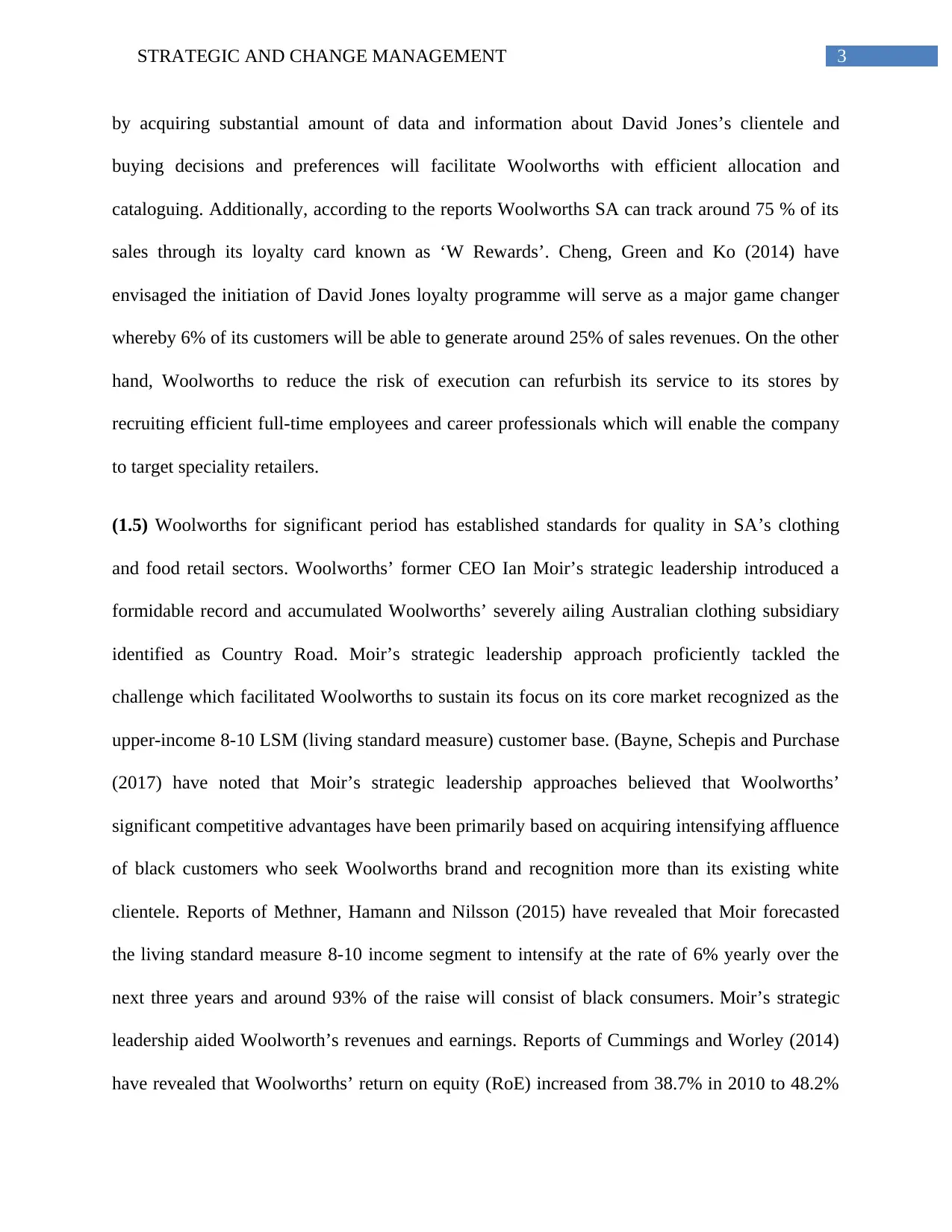
3STRATEGIC AND CHANGE MANAGEMENT
by acquiring substantial amount of data and information about David Jones’s clientele and
buying decisions and preferences will facilitate Woolworths with efficient allocation and
cataloguing. Additionally, according to the reports Woolworths SA can track around 75 % of its
sales through its loyalty card known as ‘W Rewards’. Cheng, Green and Ko (2014) have
envisaged the initiation of David Jones loyalty programme will serve as a major game changer
whereby 6% of its customers will be able to generate around 25% of sales revenues. On the other
hand, Woolworths to reduce the risk of execution can refurbish its service to its stores by
recruiting efficient full-time employees and career professionals which will enable the company
to target speciality retailers.
(1.5) Woolworths for significant period has established standards for quality in SA’s clothing
and food retail sectors. Woolworths’ former CEO Ian Moir’s strategic leadership introduced a
formidable record and accumulated Woolworths’ severely ailing Australian clothing subsidiary
identified as Country Road. Moir’s strategic leadership approach proficiently tackled the
challenge which facilitated Woolworths to sustain its focus on its core market recognized as the
upper-income 8-10 LSM (living standard measure) customer base. (Bayne, Schepis and Purchase
(2017) have noted that Moir’s strategic leadership approaches believed that Woolworths’
significant competitive advantages have been primarily based on acquiring intensifying affluence
of black customers who seek Woolworths brand and recognition more than its existing white
clientele. Reports of Methner, Hamann and Nilsson (2015) have revealed that Moir forecasted
the living standard measure 8-10 income segment to intensify at the rate of 6% yearly over the
next three years and around 93% of the raise will consist of black consumers. Moir’s strategic
leadership aided Woolworth’s revenues and earnings. Reports of Cummings and Worley (2014)
have revealed that Woolworths’ return on equity (RoE) increased from 38.7% in 2010 to 48.2%
by acquiring substantial amount of data and information about David Jones’s clientele and
buying decisions and preferences will facilitate Woolworths with efficient allocation and
cataloguing. Additionally, according to the reports Woolworths SA can track around 75 % of its
sales through its loyalty card known as ‘W Rewards’. Cheng, Green and Ko (2014) have
envisaged the initiation of David Jones loyalty programme will serve as a major game changer
whereby 6% of its customers will be able to generate around 25% of sales revenues. On the other
hand, Woolworths to reduce the risk of execution can refurbish its service to its stores by
recruiting efficient full-time employees and career professionals which will enable the company
to target speciality retailers.
(1.5) Woolworths for significant period has established standards for quality in SA’s clothing
and food retail sectors. Woolworths’ former CEO Ian Moir’s strategic leadership introduced a
formidable record and accumulated Woolworths’ severely ailing Australian clothing subsidiary
identified as Country Road. Moir’s strategic leadership approach proficiently tackled the
challenge which facilitated Woolworths to sustain its focus on its core market recognized as the
upper-income 8-10 LSM (living standard measure) customer base. (Bayne, Schepis and Purchase
(2017) have noted that Moir’s strategic leadership approaches believed that Woolworths’
significant competitive advantages have been primarily based on acquiring intensifying affluence
of black customers who seek Woolworths brand and recognition more than its existing white
clientele. Reports of Methner, Hamann and Nilsson (2015) have revealed that Moir forecasted
the living standard measure 8-10 income segment to intensify at the rate of 6% yearly over the
next three years and around 93% of the raise will consist of black consumers. Moir’s strategic
leadership aided Woolworth’s revenues and earnings. Reports of Cummings and Worley (2014)
have revealed that Woolworths’ return on equity (RoE) increased from 38.7% in 2010 to 48.2%
Paraphrase This Document
Need a fresh take? Get an instant paraphrase of this document with our AI Paraphraser
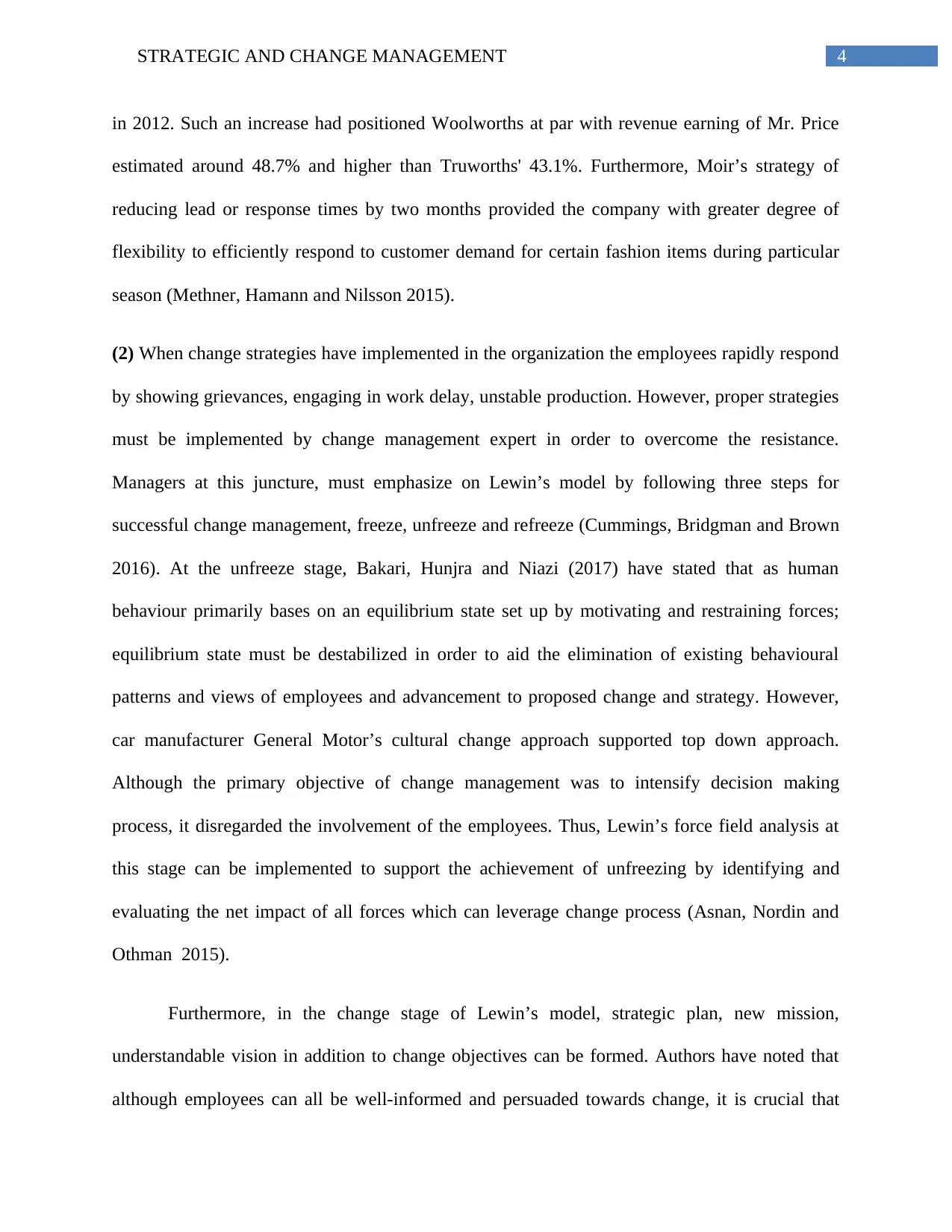
4STRATEGIC AND CHANGE MANAGEMENT
in 2012. Such an increase had positioned Woolworths at par with revenue earning of Mr. Price
estimated around 48.7% and higher than Truworths' 43.1%. Furthermore, Moir’s strategy of
reducing lead or response times by two months provided the company with greater degree of
flexibility to efficiently respond to customer demand for certain fashion items during particular
season (Methner, Hamann and Nilsson 2015).
(2) When change strategies have implemented in the organization the employees rapidly respond
by showing grievances, engaging in work delay, unstable production. However, proper strategies
must be implemented by change management expert in order to overcome the resistance.
Managers at this juncture, must emphasize on Lewin’s model by following three steps for
successful change management, freeze, unfreeze and refreeze (Cummings, Bridgman and Brown
2016). At the unfreeze stage, Bakari, Hunjra and Niazi (2017) have stated that as human
behaviour primarily bases on an equilibrium state set up by motivating and restraining forces;
equilibrium state must be destabilized in order to aid the elimination of existing behavioural
patterns and views of employees and advancement to proposed change and strategy. However,
car manufacturer General Motor’s cultural change approach supported top down approach.
Although the primary objective of change management was to intensify decision making
process, it disregarded the involvement of the employees. Thus, Lewin’s force field analysis at
this stage can be implemented to support the achievement of unfreezing by identifying and
evaluating the net impact of all forces which can leverage change process (Asnan, Nordin and
Othman 2015).
Furthermore, in the change stage of Lewin’s model, strategic plan, new mission,
understandable vision in addition to change objectives can be formed. Authors have noted that
although employees can all be well-informed and persuaded towards change, it is crucial that
in 2012. Such an increase had positioned Woolworths at par with revenue earning of Mr. Price
estimated around 48.7% and higher than Truworths' 43.1%. Furthermore, Moir’s strategy of
reducing lead or response times by two months provided the company with greater degree of
flexibility to efficiently respond to customer demand for certain fashion items during particular
season (Methner, Hamann and Nilsson 2015).
(2) When change strategies have implemented in the organization the employees rapidly respond
by showing grievances, engaging in work delay, unstable production. However, proper strategies
must be implemented by change management expert in order to overcome the resistance.
Managers at this juncture, must emphasize on Lewin’s model by following three steps for
successful change management, freeze, unfreeze and refreeze (Cummings, Bridgman and Brown
2016). At the unfreeze stage, Bakari, Hunjra and Niazi (2017) have stated that as human
behaviour primarily bases on an equilibrium state set up by motivating and restraining forces;
equilibrium state must be destabilized in order to aid the elimination of existing behavioural
patterns and views of employees and advancement to proposed change and strategy. However,
car manufacturer General Motor’s cultural change approach supported top down approach.
Although the primary objective of change management was to intensify decision making
process, it disregarded the involvement of the employees. Thus, Lewin’s force field analysis at
this stage can be implemented to support the achievement of unfreezing by identifying and
evaluating the net impact of all forces which can leverage change process (Asnan, Nordin and
Othman 2015).
Furthermore, in the change stage of Lewin’s model, strategic plan, new mission,
understandable vision in addition to change objectives can be formed. Authors have noted that
although employees can all be well-informed and persuaded towards change, it is crucial that
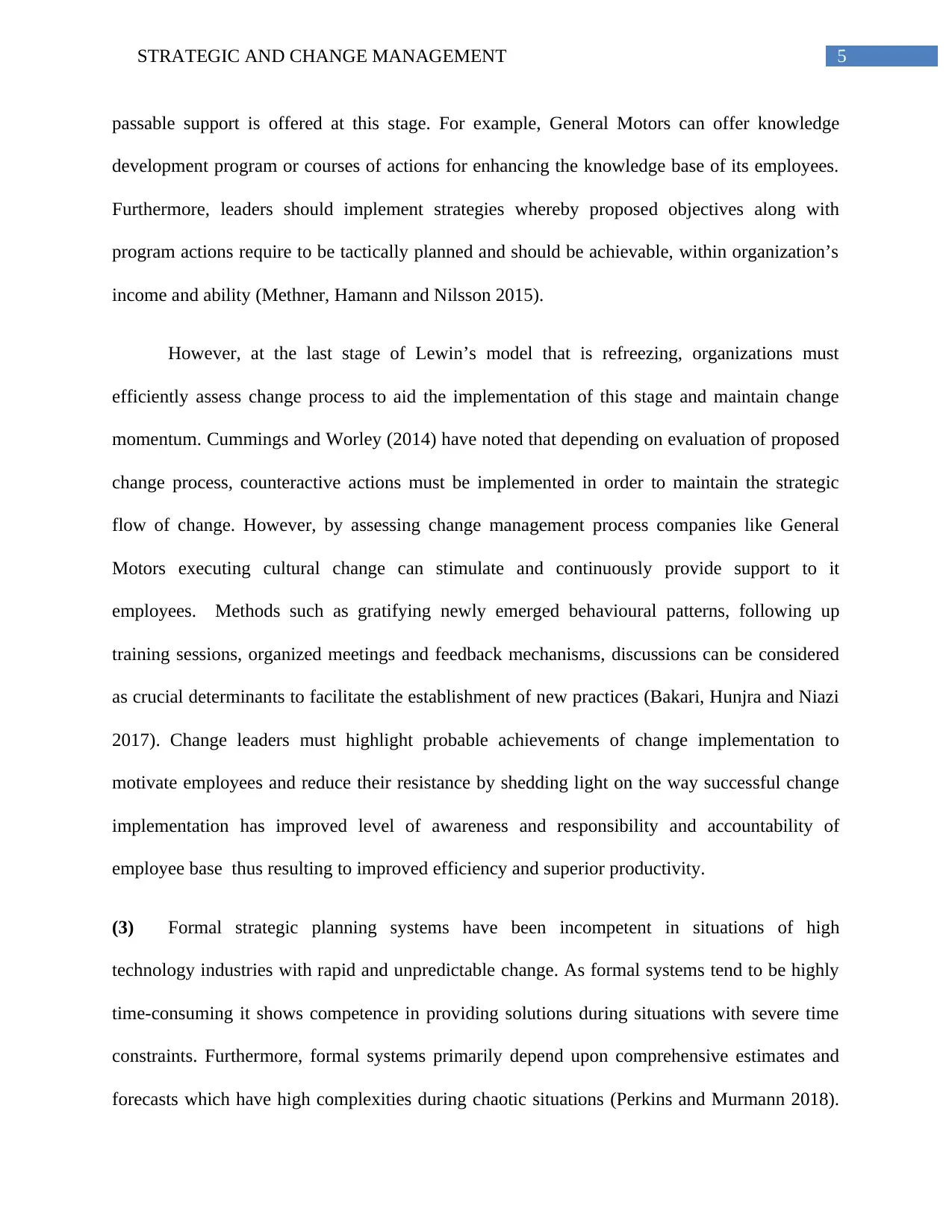
5STRATEGIC AND CHANGE MANAGEMENT
passable support is offered at this stage. For example, General Motors can offer knowledge
development program or courses of actions for enhancing the knowledge base of its employees.
Furthermore, leaders should implement strategies whereby proposed objectives along with
program actions require to be tactically planned and should be achievable, within organization’s
income and ability (Methner, Hamann and Nilsson 2015).
However, at the last stage of Lewin’s model that is refreezing, organizations must
efficiently assess change process to aid the implementation of this stage and maintain change
momentum. Cummings and Worley (2014) have noted that depending on evaluation of proposed
change process, counteractive actions must be implemented in order to maintain the strategic
flow of change. However, by assessing change management process companies like General
Motors executing cultural change can stimulate and continuously provide support to it
employees. Methods such as gratifying newly emerged behavioural patterns, following up
training sessions, organized meetings and feedback mechanisms, discussions can be considered
as crucial determinants to facilitate the establishment of new practices (Bakari, Hunjra and Niazi
2017). Change leaders must highlight probable achievements of change implementation to
motivate employees and reduce their resistance by shedding light on the way successful change
implementation has improved level of awareness and responsibility and accountability of
employee base thus resulting to improved efficiency and superior productivity.
(3) Formal strategic planning systems have been incompetent in situations of high
technology industries with rapid and unpredictable change. As formal systems tend to be highly
time-consuming it shows competence in providing solutions during situations with severe time
constraints. Furthermore, formal systems primarily depend upon comprehensive estimates and
forecasts which have high complexities during chaotic situations (Perkins and Murmann 2018).
passable support is offered at this stage. For example, General Motors can offer knowledge
development program or courses of actions for enhancing the knowledge base of its employees.
Furthermore, leaders should implement strategies whereby proposed objectives along with
program actions require to be tactically planned and should be achievable, within organization’s
income and ability (Methner, Hamann and Nilsson 2015).
However, at the last stage of Lewin’s model that is refreezing, organizations must
efficiently assess change process to aid the implementation of this stage and maintain change
momentum. Cummings and Worley (2014) have noted that depending on evaluation of proposed
change process, counteractive actions must be implemented in order to maintain the strategic
flow of change. However, by assessing change management process companies like General
Motors executing cultural change can stimulate and continuously provide support to it
employees. Methods such as gratifying newly emerged behavioural patterns, following up
training sessions, organized meetings and feedback mechanisms, discussions can be considered
as crucial determinants to facilitate the establishment of new practices (Bakari, Hunjra and Niazi
2017). Change leaders must highlight probable achievements of change implementation to
motivate employees and reduce their resistance by shedding light on the way successful change
implementation has improved level of awareness and responsibility and accountability of
employee base thus resulting to improved efficiency and superior productivity.
(3) Formal strategic planning systems have been incompetent in situations of high
technology industries with rapid and unpredictable change. As formal systems tend to be highly
time-consuming it shows competence in providing solutions during situations with severe time
constraints. Furthermore, formal systems primarily depend upon comprehensive estimates and
forecasts which have high complexities during chaotic situations (Perkins and Murmann 2018).
⊘ This is a preview!⊘
Do you want full access?
Subscribe today to unlock all pages.

Trusted by 1+ million students worldwide
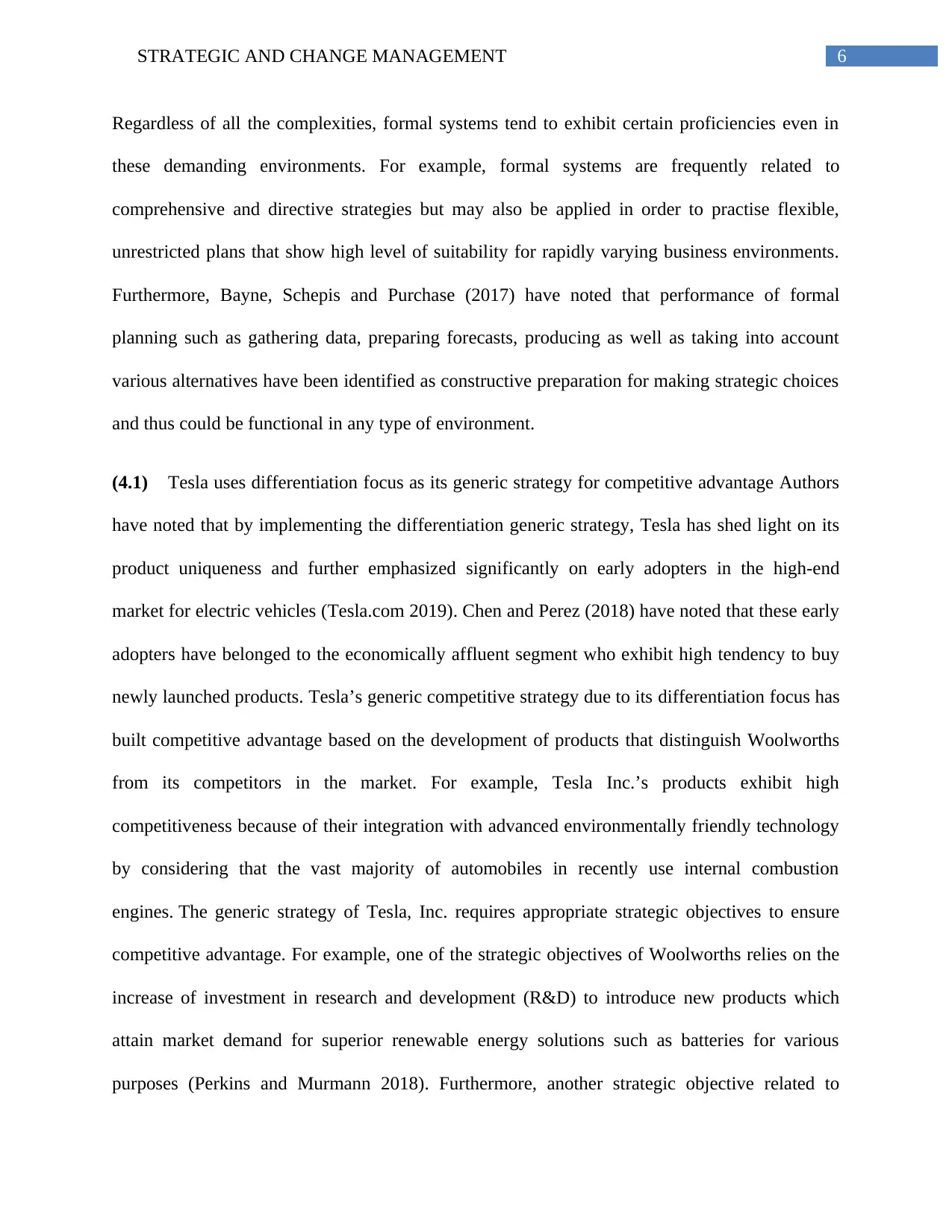
6STRATEGIC AND CHANGE MANAGEMENT
Regardless of all the complexities, formal systems tend to exhibit certain proficiencies even in
these demanding environments. For example, formal systems are frequently related to
comprehensive and directive strategies but may also be applied in order to practise flexible,
unrestricted plans that show high level of suitability for rapidly varying business environments.
Furthermore, Bayne, Schepis and Purchase (2017) have noted that performance of formal
planning such as gathering data, preparing forecasts, producing as well as taking into account
various alternatives have been identified as constructive preparation for making strategic choices
and thus could be functional in any type of environment.
(4.1) Tesla uses differentiation focus as its generic strategy for competitive advantage Authors
have noted that by implementing the differentiation generic strategy, Tesla has shed light on its
product uniqueness and further emphasized significantly on early adopters in the high-end
market for electric vehicles (Tesla.com 2019). Chen and Perez (2018) have noted that these early
adopters have belonged to the economically affluent segment who exhibit high tendency to buy
newly launched products. Tesla’s generic competitive strategy due to its differentiation focus has
built competitive advantage based on the development of products that distinguish Woolworths
from its competitors in the market. For example, Tesla Inc.’s products exhibit high
competitiveness because of their integration with advanced environmentally friendly technology
by considering that the vast majority of automobiles in recently use internal combustion
engines. The generic strategy of Tesla, Inc. requires appropriate strategic objectives to ensure
competitive advantage. For example, one of the strategic objectives of Woolworths relies on the
increase of investment in research and development (R&D) to introduce new products which
attain market demand for superior renewable energy solutions such as batteries for various
purposes (Perkins and Murmann 2018). Furthermore, another strategic objective related to
Regardless of all the complexities, formal systems tend to exhibit certain proficiencies even in
these demanding environments. For example, formal systems are frequently related to
comprehensive and directive strategies but may also be applied in order to practise flexible,
unrestricted plans that show high level of suitability for rapidly varying business environments.
Furthermore, Bayne, Schepis and Purchase (2017) have noted that performance of formal
planning such as gathering data, preparing forecasts, producing as well as taking into account
various alternatives have been identified as constructive preparation for making strategic choices
and thus could be functional in any type of environment.
(4.1) Tesla uses differentiation focus as its generic strategy for competitive advantage Authors
have noted that by implementing the differentiation generic strategy, Tesla has shed light on its
product uniqueness and further emphasized significantly on early adopters in the high-end
market for electric vehicles (Tesla.com 2019). Chen and Perez (2018) have noted that these early
adopters have belonged to the economically affluent segment who exhibit high tendency to buy
newly launched products. Tesla’s generic competitive strategy due to its differentiation focus has
built competitive advantage based on the development of products that distinguish Woolworths
from its competitors in the market. For example, Tesla Inc.’s products exhibit high
competitiveness because of their integration with advanced environmentally friendly technology
by considering that the vast majority of automobiles in recently use internal combustion
engines. The generic strategy of Tesla, Inc. requires appropriate strategic objectives to ensure
competitive advantage. For example, one of the strategic objectives of Woolworths relies on the
increase of investment in research and development (R&D) to introduce new products which
attain market demand for superior renewable energy solutions such as batteries for various
purposes (Perkins and Murmann 2018). Furthermore, another strategic objective related to
Paraphrase This Document
Need a fresh take? Get an instant paraphrase of this document with our AI Paraphraser
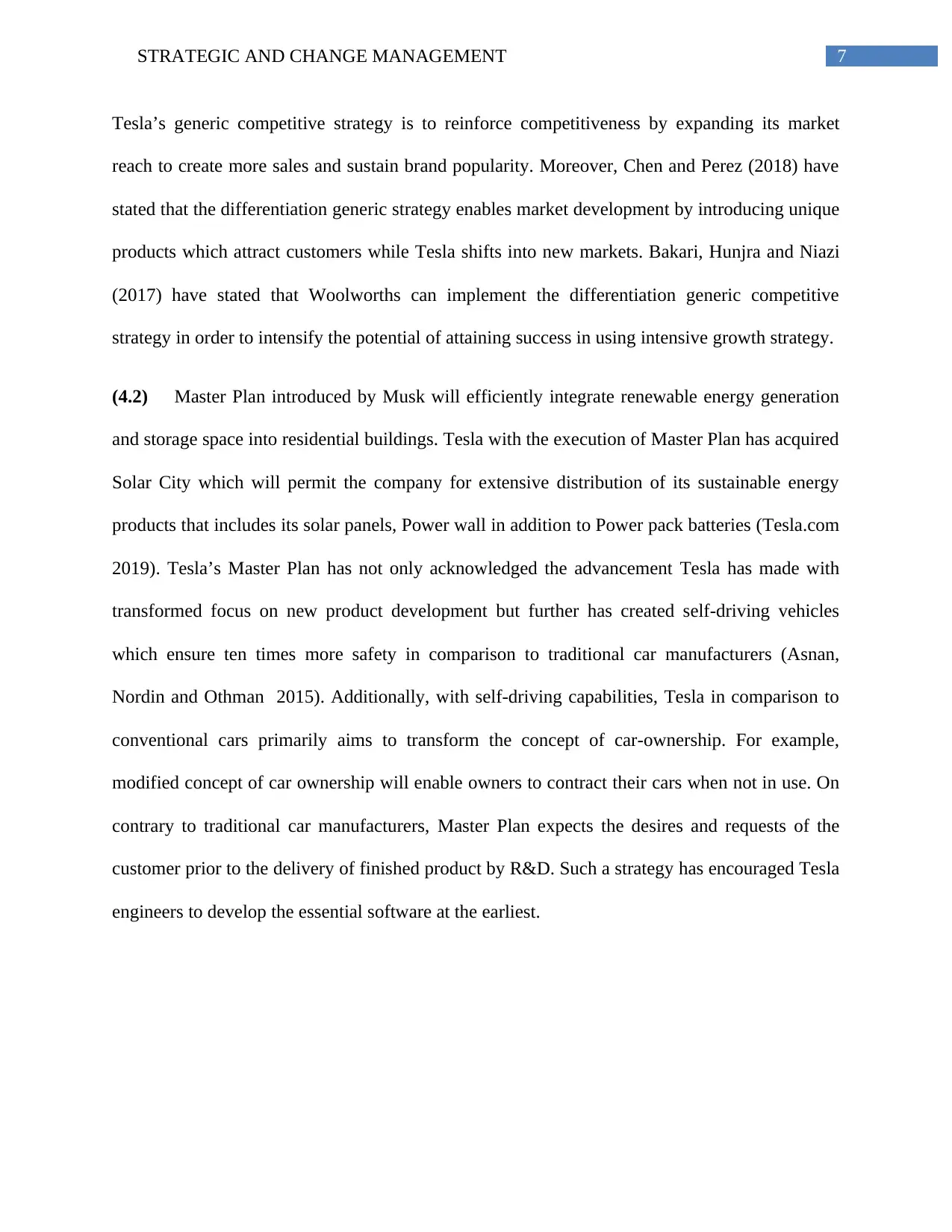
7STRATEGIC AND CHANGE MANAGEMENT
Tesla’s generic competitive strategy is to reinforce competitiveness by expanding its market
reach to create more sales and sustain brand popularity. Moreover, Chen and Perez (2018) have
stated that the differentiation generic strategy enables market development by introducing unique
products which attract customers while Tesla shifts into new markets. Bakari, Hunjra and Niazi
(2017) have stated that Woolworths can implement the differentiation generic competitive
strategy in order to intensify the potential of attaining success in using intensive growth strategy.
(4.2) Master Plan introduced by Musk will efficiently integrate renewable energy generation
and storage space into residential buildings. Tesla with the execution of Master Plan has acquired
Solar City which will permit the company for extensive distribution of its sustainable energy
products that includes its solar panels, Power wall in addition to Power pack batteries (Tesla.com
2019). Tesla’s Master Plan has not only acknowledged the advancement Tesla has made with
transformed focus on new product development but further has created self-driving vehicles
which ensure ten times more safety in comparison to traditional car manufacturers (Asnan,
Nordin and Othman 2015). Additionally, with self-driving capabilities, Tesla in comparison to
conventional cars primarily aims to transform the concept of car-ownership. For example,
modified concept of car ownership will enable owners to contract their cars when not in use. On
contrary to traditional car manufacturers, Master Plan expects the desires and requests of the
customer prior to the delivery of finished product by R&D. Such a strategy has encouraged Tesla
engineers to develop the essential software at the earliest.
Tesla’s generic competitive strategy is to reinforce competitiveness by expanding its market
reach to create more sales and sustain brand popularity. Moreover, Chen and Perez (2018) have
stated that the differentiation generic strategy enables market development by introducing unique
products which attract customers while Tesla shifts into new markets. Bakari, Hunjra and Niazi
(2017) have stated that Woolworths can implement the differentiation generic competitive
strategy in order to intensify the potential of attaining success in using intensive growth strategy.
(4.2) Master Plan introduced by Musk will efficiently integrate renewable energy generation
and storage space into residential buildings. Tesla with the execution of Master Plan has acquired
Solar City which will permit the company for extensive distribution of its sustainable energy
products that includes its solar panels, Power wall in addition to Power pack batteries (Tesla.com
2019). Tesla’s Master Plan has not only acknowledged the advancement Tesla has made with
transformed focus on new product development but further has created self-driving vehicles
which ensure ten times more safety in comparison to traditional car manufacturers (Asnan,
Nordin and Othman 2015). Additionally, with self-driving capabilities, Tesla in comparison to
conventional cars primarily aims to transform the concept of car-ownership. For example,
modified concept of car ownership will enable owners to contract their cars when not in use. On
contrary to traditional car manufacturers, Master Plan expects the desires and requests of the
customer prior to the delivery of finished product by R&D. Such a strategy has encouraged Tesla
engineers to develop the essential software at the earliest.
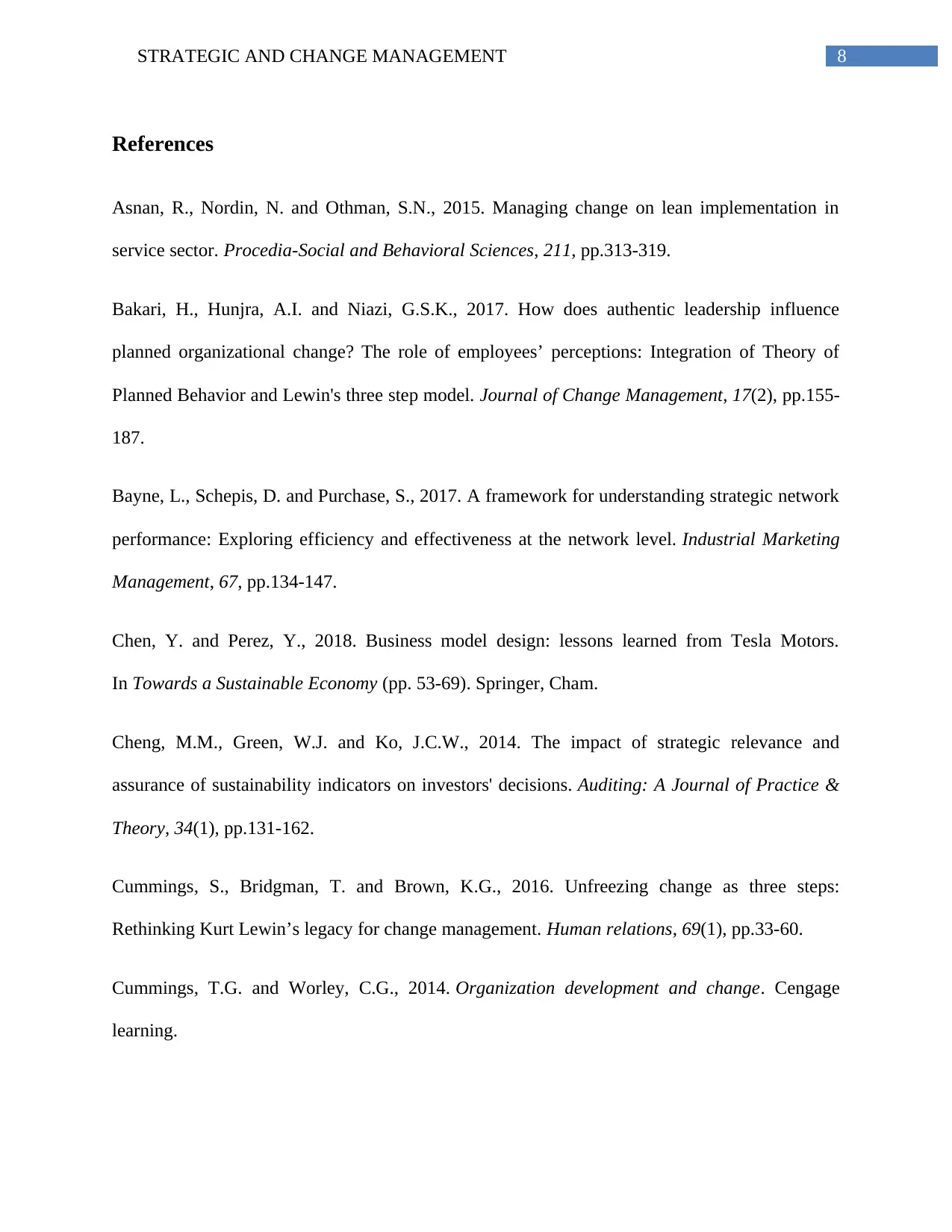
8STRATEGIC AND CHANGE MANAGEMENT
References
Asnan, R., Nordin, N. and Othman, S.N., 2015. Managing change on lean implementation in
service sector. Procedia-Social and Behavioral Sciences, 211, pp.313-319.
Bakari, H., Hunjra, A.I. and Niazi, G.S.K., 2017. How does authentic leadership influence
planned organizational change? The role of employees’ perceptions: Integration of Theory of
Planned Behavior and Lewin's three step model. Journal of Change Management, 17(2), pp.155-
187.
Bayne, L., Schepis, D. and Purchase, S., 2017. A framework for understanding strategic network
performance: Exploring efficiency and effectiveness at the network level. Industrial Marketing
Management, 67, pp.134-147.
Chen, Y. and Perez, Y., 2018. Business model design: lessons learned from Tesla Motors.
In Towards a Sustainable Economy (pp. 53-69). Springer, Cham.
Cheng, M.M., Green, W.J. and Ko, J.C.W., 2014. The impact of strategic relevance and
assurance of sustainability indicators on investors' decisions. Auditing: A Journal of Practice &
Theory, 34(1), pp.131-162.
Cummings, S., Bridgman, T. and Brown, K.G., 2016. Unfreezing change as three steps:
Rethinking Kurt Lewin’s legacy for change management. Human relations, 69(1), pp.33-60.
Cummings, T.G. and Worley, C.G., 2014. Organization development and change. Cengage
learning.
References
Asnan, R., Nordin, N. and Othman, S.N., 2015. Managing change on lean implementation in
service sector. Procedia-Social and Behavioral Sciences, 211, pp.313-319.
Bakari, H., Hunjra, A.I. and Niazi, G.S.K., 2017. How does authentic leadership influence
planned organizational change? The role of employees’ perceptions: Integration of Theory of
Planned Behavior and Lewin's three step model. Journal of Change Management, 17(2), pp.155-
187.
Bayne, L., Schepis, D. and Purchase, S., 2017. A framework for understanding strategic network
performance: Exploring efficiency and effectiveness at the network level. Industrial Marketing
Management, 67, pp.134-147.
Chen, Y. and Perez, Y., 2018. Business model design: lessons learned from Tesla Motors.
In Towards a Sustainable Economy (pp. 53-69). Springer, Cham.
Cheng, M.M., Green, W.J. and Ko, J.C.W., 2014. The impact of strategic relevance and
assurance of sustainability indicators on investors' decisions. Auditing: A Journal of Practice &
Theory, 34(1), pp.131-162.
Cummings, S., Bridgman, T. and Brown, K.G., 2016. Unfreezing change as three steps:
Rethinking Kurt Lewin’s legacy for change management. Human relations, 69(1), pp.33-60.
Cummings, T.G. and Worley, C.G., 2014. Organization development and change. Cengage
learning.
⊘ This is a preview!⊘
Do you want full access?
Subscribe today to unlock all pages.

Trusted by 1+ million students worldwide
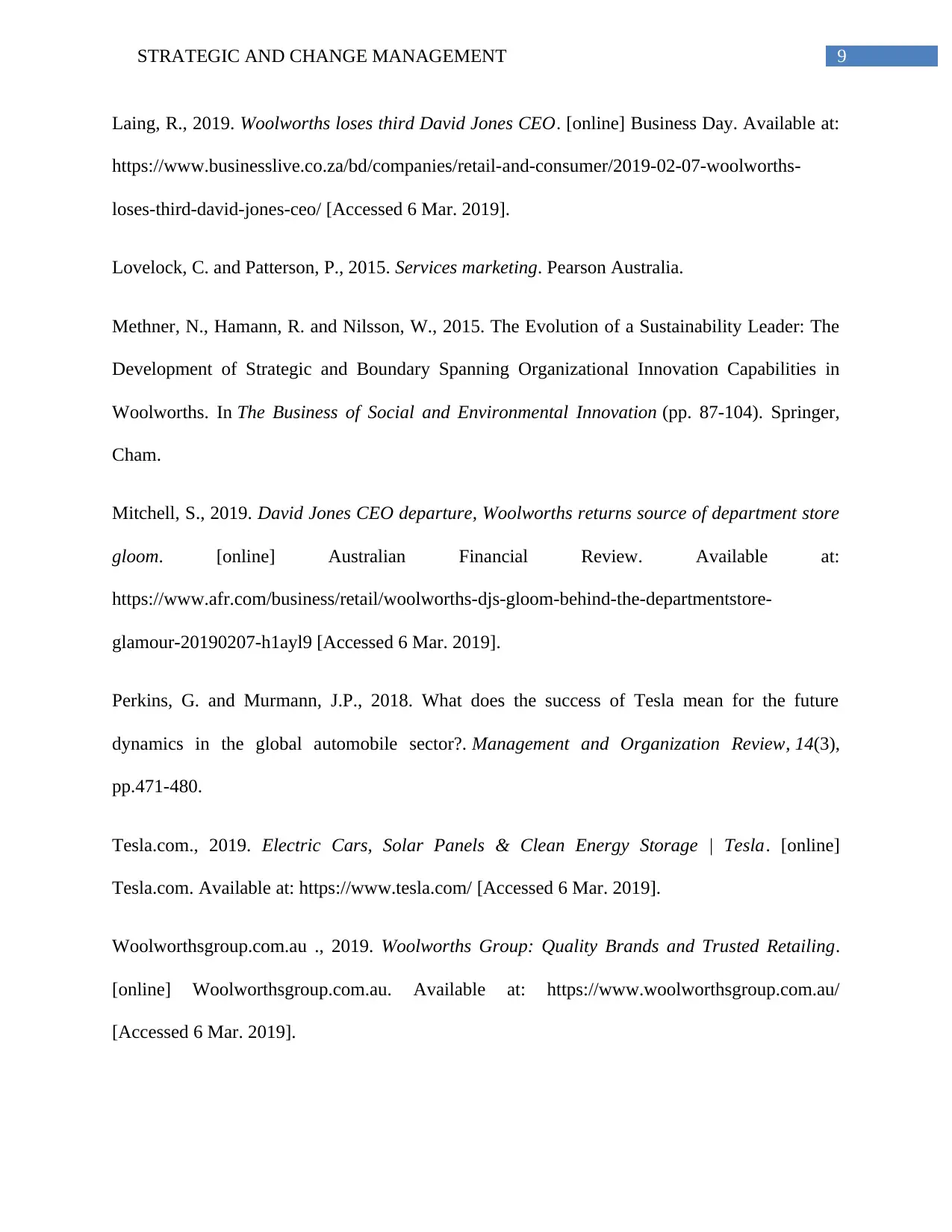
9STRATEGIC AND CHANGE MANAGEMENT
Laing, R., 2019. Woolworths loses third David Jones CEO. [online] Business Day. Available at:
https://www.businesslive.co.za/bd/companies/retail-and-consumer/2019-02-07-woolworths-
loses-third-david-jones-ceo/ [Accessed 6 Mar. 2019].
Lovelock, C. and Patterson, P., 2015. Services marketing. Pearson Australia.
Methner, N., Hamann, R. and Nilsson, W., 2015. The Evolution of a Sustainability Leader: The
Development of Strategic and Boundary Spanning Organizational Innovation Capabilities in
Woolworths. In The Business of Social and Environmental Innovation (pp. 87-104). Springer,
Cham.
Mitchell, S., 2019. David Jones CEO departure, Woolworths returns source of department store
gloom. [online] Australian Financial Review. Available at:
https://www.afr.com/business/retail/woolworths-djs-gloom-behind-the-departmentstore-
glamour-20190207-h1ayl9 [Accessed 6 Mar. 2019].
Perkins, G. and Murmann, J.P., 2018. What does the success of Tesla mean for the future
dynamics in the global automobile sector?. Management and Organization Review, 14(3),
pp.471-480.
Tesla.com., 2019. Electric Cars, Solar Panels & Clean Energy Storage | Tesla. [online]
Tesla.com. Available at: https://www.tesla.com/ [Accessed 6 Mar. 2019].
Woolworthsgroup.com.au ., 2019. Woolworths Group: Quality Brands and Trusted Retailing.
[online] Woolworthsgroup.com.au. Available at: https://www.woolworthsgroup.com.au/
[Accessed 6 Mar. 2019].
Laing, R., 2019. Woolworths loses third David Jones CEO. [online] Business Day. Available at:
https://www.businesslive.co.za/bd/companies/retail-and-consumer/2019-02-07-woolworths-
loses-third-david-jones-ceo/ [Accessed 6 Mar. 2019].
Lovelock, C. and Patterson, P., 2015. Services marketing. Pearson Australia.
Methner, N., Hamann, R. and Nilsson, W., 2015. The Evolution of a Sustainability Leader: The
Development of Strategic and Boundary Spanning Organizational Innovation Capabilities in
Woolworths. In The Business of Social and Environmental Innovation (pp. 87-104). Springer,
Cham.
Mitchell, S., 2019. David Jones CEO departure, Woolworths returns source of department store
gloom. [online] Australian Financial Review. Available at:
https://www.afr.com/business/retail/woolworths-djs-gloom-behind-the-departmentstore-
glamour-20190207-h1ayl9 [Accessed 6 Mar. 2019].
Perkins, G. and Murmann, J.P., 2018. What does the success of Tesla mean for the future
dynamics in the global automobile sector?. Management and Organization Review, 14(3),
pp.471-480.
Tesla.com., 2019. Electric Cars, Solar Panels & Clean Energy Storage | Tesla. [online]
Tesla.com. Available at: https://www.tesla.com/ [Accessed 6 Mar. 2019].
Woolworthsgroup.com.au ., 2019. Woolworths Group: Quality Brands and Trusted Retailing.
[online] Woolworthsgroup.com.au. Available at: https://www.woolworthsgroup.com.au/
[Accessed 6 Mar. 2019].
Paraphrase This Document
Need a fresh take? Get an instant paraphrase of this document with our AI Paraphraser

10STRATEGIC AND CHANGE MANAGEMENT
Woolworthsholdings.co.za., 2019. Woolworths Holdings Limited. [online]
Woolworthsholdings.co.za. Available at: https://www.woolworthsholdings.co.za/ [Accessed 6
Mar. 2019].
Xu, J., Gao, X. and Hammond, J., 2017. E-tailing in Australia: A preliminary analysis of David
Jones. The International Technology Management Review, 6(4), pp.149-157.
Woolworthsholdings.co.za., 2019. Woolworths Holdings Limited. [online]
Woolworthsholdings.co.za. Available at: https://www.woolworthsholdings.co.za/ [Accessed 6
Mar. 2019].
Xu, J., Gao, X. and Hammond, J., 2017. E-tailing in Australia: A preliminary analysis of David
Jones. The International Technology Management Review, 6(4), pp.149-157.
1 out of 11
Related Documents
Your All-in-One AI-Powered Toolkit for Academic Success.
+13062052269
info@desklib.com
Available 24*7 on WhatsApp / Email
![[object Object]](/_next/static/media/star-bottom.7253800d.svg)
Unlock your academic potential
Copyright © 2020–2025 A2Z Services. All Rights Reserved. Developed and managed by ZUCOL.





